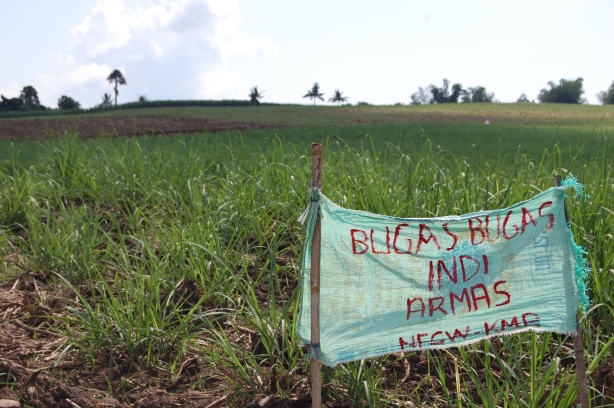In our stays in the mountains of Guihulngan, Negros Oriental, as well as here in the fisher-folk community of Mocabog, Escalante City, Negros Occidental, we have seen a situation where malnutrition is the rule, rather than exception among children. We observed in our last stay in Guihulngan in 2008 that a low-grade malnutrition was so prevalent among the children at the Kalabaklabakan school that it became invisible (normalized) very quickly, even to us.
On this trip Martha has been keeping a record of every child she does a check up with and we have also been consciously looking for the visible symptoms of malnutrition among children in the communities we stay in. It’s shocking – and while I don’t think anyone is willing to make the rational argument that widespread malnutrition among children is an acceptable state of affairs, malnutrition is the predictable outcome of the social systems shaping Philippine society: imperialism, capitalism and feudalism.
Imperialism
The political economy of the Philippines is shaped by its history of Spanish colonization and U.S. imperialism. The consequences have been a stalled feudal mode of production in much of the country, hundreds of years of plunder of the country’s rich natural resources, and forced underdevelopment – meaning economic development geared to the needs of the colonial or imperial masters.
- Sacada toils in the heat of the sugar cane
This process continues today under the aegis of the institutions of imperialist globalization: the IMF, the World Bank, the WTO, the G7, NATO and the imperialist states. In the realm of food this means that the Philippine state cannot use its budgetary or productive capacities to meet the basic nutritional needs of its citizens – such as moving towards self-sufficiency in rice production – without breaking with the institutions and structures of imperialism and facing the inevitable violent and punitive reaction.
Capitalism
The internal logic of capitalism, a capitalist food system, undermines the framework of nurturing, community, connection to the natural environment, expression of craft and love that should define the growing, preparation and eating of food and turns it into a purely commercial transaction. The commodification of food means that production is geared to profitability for capitalists and their corporations rather than to meet human needs. The capitalist imperative of profit drives the move to highly processed and sugar based ‘fast foods’ that result in malnutrition alongside overproduction and waste in the advanced capitalist countries.
The speculative chaos of the capitalist market has profound repercussions for the nutrition of the millions of Filipinos who survive on less than $2/ day. A spike in the international price of rice like we saw in 2008 means families go hungry, or start eating corn used for animal feed, which was common at that time. For children at the critical stage of development (up to 5 years when the brain is taking shape) going hungry during a period of crisis can have repercussions for their whole lives.
And rice isn’t the only commodity price that can have a major impact. Here on Negros sugar is king. When the international price is low and fields aren’t cultivated, there is no work and families go hungry. On the flip side when the price is good there is little trickle down to the workers, but the land-grabbing of the landlords increases. Meanwhile Coca Cola Corporation, who market their sugary drinks throughout the Philippines, does not buy sugar from local producers, but instead imports sugar.
Another expression of the moral bankruptcy of the capitalist food system is the marketing of junk food in areas where there is widespread malnutrition. In Barangay Trinidad in Guihulngan we went to try to buy groceries in the sitio of Kasingan, the nearest ‘town’. The small sari-sari stores all sell the same products, tiny plastic packages of Nestle coffee and powdered milk; chips and other junk food; liquor and cigarettes. Meanwhile there is a desperate need in the community for iodized salt (goiter in pregnant women is prevalent), high quality sources of protein, and vegetables. Lack of transportation and refrigeration are also major problems in the area, but the typical capitalist answer is to aggressively market products the community does not need, rather than to collectivize resources to meet the urgent needs of the people.
Feudalism
Malnutrition specifically and food security in general are, in the Philippines and in Canada, fundamentally problems of income and of the distribution of wealth. For the majority of Filipinos who are peasant farmers, the issue is land. In areas that we visited, tenant farmers who’s children experience daily hunger have to turn over 1/3 of every harvest to their landlord who has done no work to grow the food, and in many cases has never set foot on the land. This legalized form of theft, and the landlords who benefit from it, is the root cause of malnutrition in many communities.
Today we visited the camp out at Jonob-Jonob, where the farmers organization affiliated to the National Federation of Sugar Workers and the Kilusang Magbubukid ng Pilipina (KMP) have occupied 42 hectares of farm land where they were formerly sacadas, or day labourers. The people we met there were visibly more healthy, well fed, and happier than any other community we have visited in our time in the Philippines; there was a light in their eyes, their skin of the children was clear of infections, the small children were almost all of normal weight, and the youth appeared cheerful.
The lesson I draw from this is that having land is good for your health and land redistribution (or genuine land reform as they call it here) is the best way to really tackle the problem of malnutrition as well as a host of other health problems in the Philippines.
BUGAS, BUGAS, INDI ARMAS! (rice, rice, not arms!)




